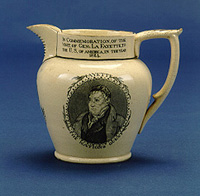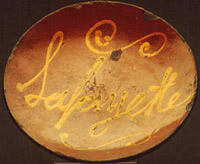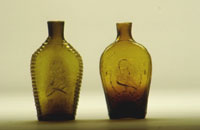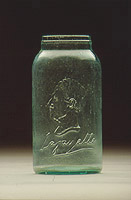|
|
Lafayette College
The Marquis de Lafayette Collections |
|
|
Lafayette College
The Marquis de Lafayette Collections |
The Memorabilia Collection, ca. 1780 -
The Marquis de Lafayette Memorabilia Collection, ca. 1780 -
(22 linear feet -- 4 oversize shelves), contains approximately 800 historical
objects relating to the life of Lafayette. Materials are organized
into the following series:
Series I (Box 1-16) houses nearly 50 pieces of historical ceramic tableware
related to the Marquis de Lafayette. These ceramics are decorated
with portraits of Lafayette as well as scenes from his life.  The
series is organized into two major groupings: Staffordshire and miscellaneous
pottery. Types of ceramic pieces include platters, plates, bowls,
pitchers, and cups.
The
series is organized into two major groupings: Staffordshire and miscellaneous
pottery. Types of ceramic pieces include platters, plates, bowls,
pitchers, and cups.
The Staffordshire (Box 1-11, 17) represents the bulk of the ceramics
series. The brilliant cobalt blue transfer-printed scenes of historical
Staffordshire traditionally convey the strong patriotic sentiment of 19th-century
America. Lafayette was a popular subject for these commemorative
pieces along with other Revolutionary War heroes. Manufactured in England after 1825, these patriotic ceramics were designed
for the American market.
Manufactured in England after 1825, these patriotic ceramics were designed
for the American market.
The Staffordshire ceramics include a variety of Lafayette-related designs.
Views of Lafayette's home, LaGrange, are found on pieces produced by Enoch
Wood and Sons of Burslem, one of the largest Staffordshire exporters to
the United States. These designs were based upon works by American
artist, Alvan Fisher. Corresponding lithographs for these Fisher
designs can be found in the print collection (XXIII.7-10). Several Wood
and Sons ceramics also carry a mourning scene depicting Lafayette seated
near an urn bearing the name of his departed friend, Benjamin Franklin.
The J. and R. Clews Staffordshire, based upon the design of American artist
Samuel Maverick, shows Lafayette's landing at Castle Garden, New York,
on August 16, 1824. This was one of the most popular of the
early Staffordshire patterns and it is the predominant pattern in this
collection.  English
manufacturer Mayer Stoke is represented by several pieces with a transfer-print
depicting Lafayette at George Washington's tomb.
English
manufacturer Mayer Stoke is represented by several pieces with a transfer-print
depicting Lafayette at George Washington's tomb.
While these scenes are printed in the cobalt blue of traditional Staffordshire, several ceramic pieces in the collection have been identified as Staffordshire without this distinguishing characteristic. For the most part, these are commemorative pitchers produced by Richard Hall and Sons, carrying a portrait of Lafayette after the Ary Scheffer painting of 1822. These transfer-prints in black are placed upon an off-white background.
The ceramics located in the miscellaneous grouping of Series I (Box
12-16) include a wide variety of commemorative pieces. Although most
of these pieces are plates manufactured during the 20th-century, several
are examples of pottery produced ca. 1824-30, during or after Lafayette's
last visit to the United States.
The 19th-century glassware of Series II (Box 1-2) includes flasks, jars,
cup plates, and salt cellars.  The
flasks appear in pint or half-pint sizes and are either aquamarine, green,
or olive amber in color. Of the five flasks in the collection, two
(II.1,2) are products of the Kensington Glass Works, Philadelphia, Pennsylvania,
and three (II.3,4,5) are from a manufacturer in Coventry, Connecticut.
All the flasks carry a bust portrait of Lafayette blown into the glass
and date after his 1824-25 visit to America.
The
flasks appear in pint or half-pint sizes and are either aquamarine, green,
or olive amber in color. Of the five flasks in the collection, two
(II.1,2) are products of the Kensington Glass Works, Philadelphia, Pennsylvania,
and three (II.3,4,5) are from a manufacturer in Coventry, Connecticut.
All the flasks carry a bust portrait of Lafayette blown into the glass
and date after his 1824-25 visit to America.
The collection includes two mason jars (II.6,7) with a bust portrait
of Lafayette and a "Lafayette" signature in script below,  and
six pressed glass cup plates manufactured at the Boston and Sandwich Glass
Company of Sandwich (Cape Cod), Massachusetts. Cup plates were used
during the 19th century to place tea cups on after the tea had been poured
into a saucer to cool. Five cup plates depict the Bunker Hill Monument
(II.8,10,11,13,14) and date ca. 1841, while a more delicately designed
cup plate shows Lafayette's ship the "Cadmus" and dates ca. 1825 (II.9).
It is possible that this cup plate is one of the first pieces of glass
to be pressed at the Sandwich Works. Finally, the collection includes
two salt cellars. One (II.12), produced at either the New England
Glass Company or at the Boston and Sandwich Glass Company, both of Sandwich
(Cape Cod), Massachusetts, may very well be one of the earliest historical
salt cellars known, with bust portraits of both Lafayette and Washington.
The other (II.15) is a Sandwich Glass cellar in the shape of a paddle boat.
and
six pressed glass cup plates manufactured at the Boston and Sandwich Glass
Company of Sandwich (Cape Cod), Massachusetts. Cup plates were used
during the 19th century to place tea cups on after the tea had been poured
into a saucer to cool. Five cup plates depict the Bunker Hill Monument
(II.8,10,11,13,14) and date ca. 1841, while a more delicately designed
cup plate shows Lafayette's ship the "Cadmus" and dates ca. 1825 (II.9).
It is possible that this cup plate is one of the first pieces of glass
to be pressed at the Sandwich Works. Finally, the collection includes
two salt cellars. One (II.12), produced at either the New England
Glass Company or at the Boston and Sandwich Glass Company, both of Sandwich
(Cape Cod), Massachusetts, may very well be one of the earliest historical
salt cellars known, with bust portraits of both Lafayette and Washington.
The other (II.15) is a Sandwich Glass cellar in the shape of a paddle boat.